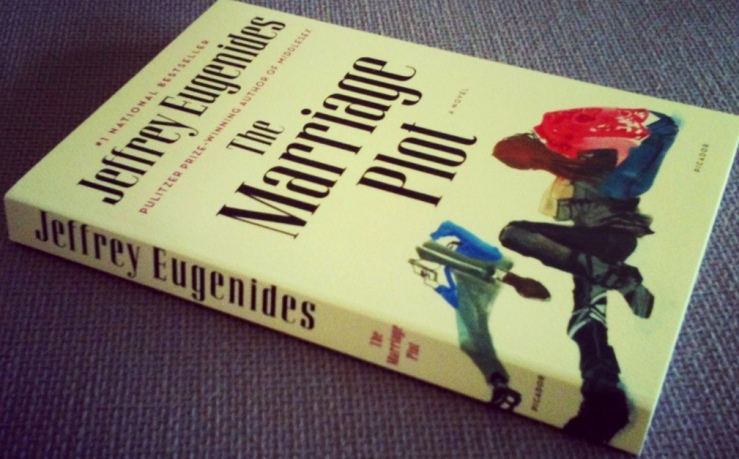
I have just now finished George Eliot’s novel Silas Marner, which I enjoyed. The novel is set in England at the beginning of the nineteenth century, and its plot goes something like this:
As a young man, Silas Marner, a weaver, is a member of a nonconformist church with Calvinist tendencies. Falsely accused of theft, he is excommunicated from his church. Divided from the only community he knows, he loses faith in humanity and religion, leaves his “native place” Lantern Yard in Northern England, and moves to Raveloe, a village in the Midlands.
(Lantern Yard and Raveloe are both Eliot’s inventions, like Middlemarch in Middlemarch. And while Silas Marner is much shorter than Middlemarch, the world Eliot conjures in Raveloe is nevertheless similarly rich and full and detailed, a real fake place, a spot in the Eliotverse).
Silas’s technological prowess at the loom finds him plenty of customers in Raveloe, and while he amasses a wealth in gold coins, testifying to his weaving’s popularity, he nevertheless remains isolated from the community. For a decade and a half he hoards his gold coins, counting them late into the night alone at home, and cementing his reputation as an eccentric with the Raveloe folk. He’s always the Stranger.
In the meantime, Raveloe’s wealthiest family, the Casses, continue their lives as obnoxious rich assholes. The elder son Godfrey harbors a shameful secret, the younger son Dunstan is an alcoholic ne’er-do-well, and Papa Cass—excuse me, Squire Cass—is a pompous prick. There’s a ruined horse, an opium-addicted wife, a Christmas Party ruined by a visit from big-A Anxiety. Etc.
Through a series of skillful plot-moves, Eliot meshes the Cass story line with Marner’s story weaving the two together around the novel’s central conceit: Silas Marner’s hoard of gold is stolen. Soon after, he finds a baby girl, whose golden curls he takes as a kind of symbolic exchange for his golden coins. The girl saves his life in the sense that she saves his soul. Eliot gives us this moving exchange between adopted father and daughter near the end of the novel:
“But I know now, father,” said Eppie. “If it hadn’t been for you, they’d have taken me to the workhouse, and there’d have been nobody to love me.”
“Eh, my precious child, the blessing was mine. If you hadn’t been sent to save me, I should ha’ gone to the grave in my misery. The money was taken away from me in time; and you see it’s been kept—kept till it was wanted for you. It’s wonderful—our life is wonderful.”
There is nothing like a character declaring something like “It’s wonderful–our life is wonderful” to signal an impending moment of the unwonderful, of course, and Godfrey Cass barges into the life of Silas Marner on queue. Old secrets come to light, etc.
But there is a happy ending, a classically comic ending, with a wedding and a garden and laughter and everything.
I do not think my plot summary spoils too much, or at least I very much hope it spoils nothing. I went into Silas Marner not knowing anything about the plot, and, after writing my little summary, I can see how the novel might be misinterpreted as a tad, uh, sentimental. And it does earn its emotional ending, that’s true. But, as in Middlemarch, it’s really the way that Eliot captures emotion—psychology, intention, bewilderment—-that so compels me.
Silas Marner is a novel about conscience and consciousness, anxiety and isolation, strangers and community. It is a novel about knowing, but it is also very much a novel about not knowing. The novel’s strange hero Silas Marner is a weaver, a symbolic doubling for an author, sure, but Silas Marner is a novel that points to its own loose threads.
This theme of not knowing is most evident in the final paragraphs of the novel’s final numbered chapter. There is a chapter titled “Conclusion” after the final numbered chapter, and this chapter “Conclusion” gives us the classical comedic ending of a wedding in a garden and, you know, happily ever after. This “Conclusion” gives the text a sense of resolution that the novel’s final numbered chapter withholds. I find Eliot’s evocation of not knowing in the final numbered chapter a far more persuasive indicator of the emerging modernism I read in her novels.
In this final numbered chapter (Chapter XXI), Silas takes his daughter Eppie to the North, to Lantern Yard. He wants to show his daughter his “native place,” but he also wants to confront Mr. Patson the minister of the church that excommunicated him. He wants to demonstrate his innocence to the minister. He wants this member of his old community to know himself the way he knows himself; he wants to know that the minister knows what he himself knows.
Silas and Eppie are aghast at Lantern Yard though—the place looks awful and smells bad; none of it is as Silas had known it. It is a new place, an industrialized place. Even the church where he had worshiped is gone, replaced by a factory. And his detective work does not pay off:
But neither from the brush-maker, who had come to Shoe Lane only ten years ago, when the factory was already built, nor from any other source within his reach, could Silas learn anything of the old Lantern Yard friends, or of Mr. Paston the minister.
When Silas returns to Raveloe, he confides in his friend Dolly Winthrop, who serves as kind of leveling conscience in the novel, telling her:
The old home’s gone; I’ve no home but this now. I shall never know whether they got at the truth o’ the robbery, nor whether Mr. Paston could ha’ given me any light about the drawing o’ the lots. It’s dark to me, Mrs. Winthrop, that is; I doubt it’ll be dark to the last.
Silas has reconciled himself to the darkness of not knowing; there’s no teleological neatness in this conclusion. Teleological neatness is reserved for “Conclusion” —for the wedding, the garden, the laughter. And it’s in those human moments, moments that serve to counter his early years of isolation, that Silas finds “light enough to trusten” the human race he once rejected. Silas weaves the dark loose ends of his old life into something new and bright, and in this way, preserves his soul.

















